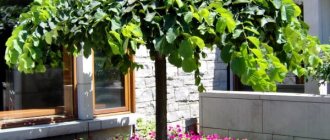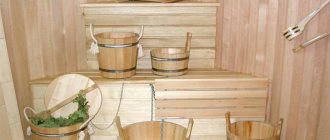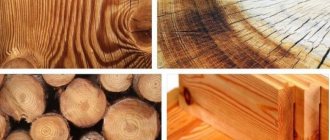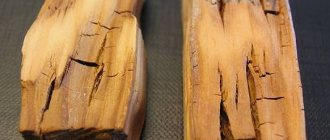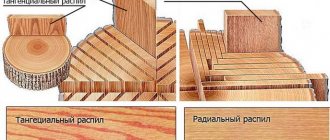Elm wood, due to its physical properties, is durable, moisture-resistant and easy to process. Therefore, elm lumber is widely used in the manufacture of furniture and related wooden products. Elm can rightfully be called industrial wood. The scope of application of elm material is very wide. It is used in the furniture industry, the manufacture of souvenirs and toys, mechanical engineering and the production of industrial equipment. Plywood and chipboard are also made from elm trees.
Elm processing
When processing elm wood, standard carpentry equipment is used. But due to its properties of strength and hardness, elm is rarely cut to give rounded shapes. There is a technology for bending elm in which it is steamed and processed. Upon subsequent drying, it is restored to its original strength and holds its shape perfectly. Difficulties also arise when polishing elm. Therefore, it is often varnished or covered with decorative compounds. Elm tolerates chemical exposure well. The wood material adheres well and is “friendly” with metal parts.
Tables made of slabs and epoxy resinWorkshop TABLE RIVER, St. PetersburgPhone: +7 (812) 627-65-09
Elm or oak. Comparison of two types of wood. What is the best material to make a table from?
Elm or oak. What is the best material to make a slab table from?
We are often asked a question by our clients, and the question is very simple: what kind of wood is best to make a slab table from? Which is better - elm or oak ? In order not to answer this question by phone for the hundredth time, we decided to write an article that tells, point by point, a comparison of these two famous wood species. Please spend 5 minutes reading and then a lot will become clear to you
The elm tree belongs to the genus of trees of the Elm family, grows in the southern zone of the European part of Russia, in the Crimea, the Caucasus and Central Asia. Often in the steppe zone it is a companion of oak. Elm wood is durable, hard and elastic. Unlike oak, elm wood does not splinter. If we compare oak and elm, they are almost identical, but elm is easier to work with and elm has a more interesting and varied structure. Oak also releases resins that can react with epoxy resin, and this can happen several years after the table is made from slab and epoxy resin. This is another important point in favor of choosing elm rather than oak for making a slab table. Well, by the way, elm is a little cheaper than oak
Bottom line: to make a table from slab it is better to choose elm rather than oak
The characteristics of the elm breed are determined by the following criteria: strength, density, resistance to cracking, resistance to rotting, wear resistance, flexibility, low knottiness and lightness. If we evaluate elm wood according to all these criteria, we can draw the following conclusion: elm wood has excellent wear resistance and flexibility. What does the concept of wear resistance mean? Wear resistance is the ability of wood to resist destruction during friction. As you know, elm is a hard and dense type of wood, so the wear of this tree will be minimal. This property of wood is one of the main ones when choosing wood for the construction industry, which is why tables made of elm slabs are more popular than tables made of oak slabs
The next important criterion for elm is flexibility. The flexibility of a tree is its ability to bend well and not straighten, without breaking or collapsing. Moisture is of great importance for flexibility. After all, the more moisture the wood contains, the less flexible it becomes. In order to reduce the percentage of moisture contained in the wood, it is steamed. Elm has very good flexibility, which allows it to be used in the manufacture of furniture, namely tables made of slabs and epoxy resin . However, there is one more property of this wood, which we already mentioned earlier - its texture. Elm, elm, elm (dense, durable species) - these species, due to their beautiful texture, are widely used in furniture and plywood production. Having great strength, they are used in mechanical engineering and carriage building. The wood of elm, elm, and elm is distinguished by its strength, viscosity, and density. It resists wear well and bends well. This is quite important when it comes to the mechanical impact on the external surfaces of a slab table . In terms of its properties, elm wood is close to oak. It is quite difficult to process, but with skillful use the result will exceed all expectations. The wood practically does not warp or crack when drying. After painting and polishing, the surface becomes perfectly smooth and shiny. This happens due to the reduced number of pores in the wood structure when compared with oak wood
For those who are interested in what the tree itself looks like, the following information will be of interest. Elm is a deciduous tree of the elm or elm family. This is a very ancient tree species. The species is believed to be over 30 million years old. The height of elm can reach forty meters. The girth of the trunk of such tall trees can be up to two meters. The wood is light, with a yellow tint and a very beautiful structure. I would also like to note that the wood of this tree has a subtle aroma that acts on a person like an antidepressant. Tables made from elm slabs thus even provide minor medicinal benefits as aromatherapy. The beautiful structure of the wood and the unusual bright texture of the cut, high performance characteristics - all this convinces us of the need to purchase a table made of Karagach wood
Karagach characteristics:
Elm by its nature is a deciduous tree that belongs to the elm family. In turn, the elm family belongs to the sound-bearing species. Some specimens of trees of this species reach a height of 30 meters, and a diameter of almost 1.5 m - 2.0 m. The main growth zone of elm is the forest-steppe and steppe zones of Russia, as well as neighboring countries and Central Asia. If we look carefully at a cut of an elm tree, we will see clearly visible annual layers and pith rays. The presence of medullary rays contributes to the appearance of characteristic ebbs. Mature elm wood consists of small layers, which are mostly yellow-brown or light brown in color with brown or red-brown inclusions. In the open air, under the influence of sunlight, elm wood gradually darkens. The structure of the wood fibers is smooth or slightly wavy. As for the texture of elm, it is completely unique and has a characteristic shine. Karagach has a very wide scope of application. Let's take a closer look at all the main uses of elm wood. First of all, when choosing a tree to be used in a particular area of the economy, they pay attention to such a concept as the characteristics of the species. Another advantage of wood from the elm family, and elm belongs specifically to this family, is its resistance to moisture. This is an additional bonus for those who want to install a table made of elm slab, for example, in a dressing room and are afraid of the effect of humidity on the tabletop
If you are thinking about what kind of wood it is better to order a slab table , then we recommend elm. It is much better than other types of wood. If we compare oak and elm , then based on the above facts we can confidently give preference to elm. In a word, elm and oak are very similar, but elm for a slab table is better and more practical
We have been making tables from elm slabs - tables from solid oak - for many years
You will like our prices for solid wood tables
Elm - material for beginner carpenters
Due to its prevalence and unpretentiousness, elm is ideal for novice carpenters and furniture makers. Elm with durable wood , almost completely corresponds to oak species. At the same time, it is easier to process, and the cost of the material is lower. The range of applications for vase lumber is varied. You can make both stools, so to speak, to get your hands on, and more complex furniture from elm using turning and carving. In both cases, the product will last a long time and reliably. Elm sapwood has a light yellow, uniform texture, so the product can be coated with any stains and varnishes. Thus, you can achieve the effect of a more expensive type of wood, and elm is certainly not inferior to it in terms of strength.
Elm. Properties of wood
Elm is a sound wood species. The ring-vascular sapwood is light yellow, the heartwood is slightly darker to light brown. Elm wood is of a noble shade, has a beautiful, interesting appearance, with a clearly defined natural pattern.
The density of dry elm wood is 500-600 kg/m3. These indicators are close to birch wood.
Elm wood is characterized by high hardness, wear resistance, toughness, and elasticity. Therefore, wood is quite difficult to split and saw, but it takes processing, grinding, polishing well and bends well.
Elm firewood has high thermal conductivity. When dried, lumber practically does not crack and is not subject to warping.
Elm is used for the production of furniture and decorative elements (wooden frames), parquet, baseball bats, as well as products that require the flexibility of the material
Interesting:
The first London Bridge was built on elm piers. And in the Middle Ages, water pipes were made from elm tree trunks. This is due to the fact that elm has a very high resistance to rot. But durability is significantly reduced when wood comes into contact with soil.
Elm veneer
Elm, which grows in the vast expanses of the Eurasian continent, is called white elm. It is not suitable for veneering, as it is susceptible to disease. Due to the disease of the species, there is a risk of partial or complete destruction of the wood structure. But there is an alternative option for producing elm veneer. The so-called American elm or red elm is excellent for veneer production. At the same time, it has a reddish-brown texture, which makes it more exotic. This elm grows in both Americas and Canada. The use of solid wood is not economically feasible in our region. But it is beneficial to use veneer. It will not only create a beautiful visual effect, but will also perfectly protect cheaper types of wood from mechanical damage.
How to make wood cutters with your own hands
Discussion: 6 comments
- Lika:
01/23/2013 at 6:01 pmIn my opinion, not much attention has been paid to aspen... It makes wonderful things in the hands of a skilled person. I am familiar with Finnish dishes - original, although simple, it seems to look beautiful, and is also practical - you can use it all the time, easy to wash...
Answer
admin:
01/24/2013 at 3:31 pm
Agree.
Answer
- Evgeniy Yurievich Minin:
03/12/2018 at 1:17 pm
Surprisingly, the girl is more observant than her husbands 5+
Answer
09/29/2015 at 1:19 pm
Bird cherry and elm (acacia) are undeservedly not mentioned. Bird cherry, especially old ones, from 20 cm in diameter, has a wide palette of colors. Products made from it exude the well-known May smell for a long time. Elm is very durable. Color - golden. But it is only suitable for making jewelry or any small items, because... this is a bush.
Answer
- Andrey:
09/19/2019 at 8:22 pm
Karagach is not a promotion at all... What kind of special is this? Elm is the same elm, only small-leaved. And it grows quite large. And its prevalence is the same as birch, with the exception of very northern latitudes. In Russia, perhaps, it is not found only in the Arctic.
Answer
01/14/2017 at 7:19 am
Hi all
Answer
Interesting facts about elm
Elm has several names - elm, birch bark and elm. This plant has more than 30 varieties. Some plant specimens lived up to 400 years.
Our ancestors widely used elm for domestic purposes. In the Cheboksary Beer Museum there is a copy of a beer barrel, the rims of which are made of elm. Elm was also used to make skis for sleds and sleds. The flexibility of the species made it possible to bend the most bizarre shapes, and the strength of the wood allowed the products to serve for a long time. According to some sources, the elm sled was passed down to three generations, and later became a museum piece. American elm bark is used for medicinal purposes. A tincture of the bark is used to treat diseases of the throat and respiratory tract. Thanks to a special mucous substance, elm bark has excellent antiseptic properties.
The catchphrase “elm and grapes” denotes lovers who remain unshakably faithful to each other.
This is related to the parable in which a grape vine entwined itself around an elm tree, and during a severe drought it produced a wonderful harvest. This phenomenon can be explained from a biological point of view. The extensive foliage protects the grapes from the sun, and the deep bark system of the elm feeds the grapes with moisture. Tags: elm, wooden furniture, Elm furniture
Elm is a tree that cannot be broken
November 7, 2022 Elms belong to relict tree species that appeared about 40 million years ago.
Their center of origin is Central Asia, from where they spread to most of the Northern Hemisphere: they settled throughout Eurasia and North America. Ten thousand years ago, when the climate on Earth was milder than today, Europe and the British Isles were completely covered with broad-leaved forests, dominated by oak, linden and elm. Then people came and started farming...
Now elms in Britain are found only in artificial plantings, but their Latin name “ulm” has English roots.
Botanical description of elm
Elm, or elm (Ulmus) is a genus of large trees widespread in mixed and deciduous forests of the central and southern European part of Russia. The tree extends beyond the Urals in the form of small “islands”. In total, the genus includes 30-40 species, the ambiguity of the number of which is explained by the difficulty of distinguishing them due to the ease of interspecific hybridization.
Some species in Russia are known under other names, for example, the word “berest” is used to describe the small elm (in the south of the European part of Russia, in the Caucasus), and “elm” (from the Turkic “ebony”) is the name for the squat elm (Volga region, Southern Urals, Caucasus).
The trees can be giants and reach 40 m in height, often their trunk bifurcates or is divided into many trunks. Less common are elms in the form of shrubs.
The bark of the elm is gray or brown, smooth in young plants, but with age it cracks and comes off in layers.
leaves are two-row, short-petioled, with early falling stipules. Their characteristic feature is the asymmetry of the leaf blade at the base. The leaves are oval or ovoid in shape with a pointed tip. The leaf length is from 4 to 20 cm. They are serrated or double-toothed along the edge, glossy on top and matte pubescent below. The leaf arrangement is alternate and so dense that the crown of the tree allows almost no light to pass through. In autumn, the leaves turn yellow or reddish-brown and fall off earlier than those of other species. But not all elms are deciduous trees; some of them are evergreen.
Elm grows very quickly; at about 60 years of age, its vertical growth slows down, but active thickening of the trunk begins, sometimes reaching 1 m in diameter. In terms of strength, elm can only be compared with oak, and also in terms of wood density (about 650 kg/m3).
The crown of the elm is ovoid with a truncated top, dome-shaped or almost spherical, and tolerates pruning well.
The roots are flat, disc-shaped, sometimes located at the base of the trunk. In most species, root system lacks a main root; it is usually powerful and deep. On strongly podzolic soils - superficial.
The tree is often dioecious, sometimes monoecious. Flowers are bisexual or unisexual. Pistillates can be solitary. More often, the flowers are collected in an inflorescence - a semi-umbrella, located in the axil of the leaves. Perianth petals 4-5, less often 3-8. There are as many stamens as there are petals or twice as many, pistil 1. Each individual flower hangs on a long thread-like peduncle, which, after fertilization of the ovary of the pistil, lengthens even more and the inflorescence takes on the appearance of a crumbly brush.
Elm blooms in April-May before the leaves bloom, like other wind-pollinated plants; in early springs it is valued as a honey plant. The exception is small-leaved elm, which blooms in the fall. The fruit of the elm is a nut or drupe, located in the center of the lionfish. Seeds are dispersed by the wind.
The tree grows well in fertile soils; some species of the genus tolerate salinity or dry habitats. All species are shade-tolerant, and with sufficient lighting they form a powerful crown. Thanks to the density of the leaf mosaic, they themselves form a dense shadow. They reproduce by seeds, stump shoots and root suckers.
Use of elm in economic activities
The average lifespan of elm is 80-120 years. 400-year-old specimens are known.
wood is hard, strong, viscous, elastic, easy to process, but difficult to split. Its heartwood is dark brown, the sapwood is lighter with a characteristic pattern of broken or parallel stripes, with narrow core rays. In water it resists rotting well, but this ability is lost upon contact with soil. A growing tree is often attacked by insect pests and parasitic fungi.
The first written mentions of elm date back to the Mycenaean period. The chariots used in the Battle of Knossos had wheels made of elm wood. In Ancient Greece, plows were often made from it. And elm burns excellently; its wood tends to ignite even when wet. Any fire can be easily lit from the logs of this tree. Yes, you can light a fire from logs, but cooking these logs is not so easy. However, we conducted an experiment: although elm does not famously scatter into logs, it is still not difficult to chop firewood from it if you get a good tool.
The Russian name of the tree speaks for itself - elm - from “knit” or “knit”. In the old days, sleighs, rims and other products were knitted from its bast. And for those who have chopped elms for firewood, the second meaning of this name is clear - if you drive an ax into a log with all your might, but it’s still intact, and you can’t even pull the ax out - it gets stuck. It is difficult to split an elm block because the layers of the tree's wood are uneven and difficult to separate from each other.
People use elm very widely:
- fruits - as a highly nutritious feed for pigs and other domestic animals. Young branches and bark are also used to feed livestock;
- for landscaping cities, since many of them are undemanding to living conditions. But in the steppes they suffer greatly from pests. In Europe and North America, the era of elm landscaping ended between World Wars I and II, when the trees were damaged by war and an outbreak of Dutch elm disease. The revival of plantings began in the 1990s. Then new, more resistant varieties of elm were developed. In total there are about 300 new varieties of wood. And the old pre-war varieties were lost;
- as an early honey plant;
- Due to its high density, elm is difficult to cut and split, but bends quite well. The smooth surface of the material tolerates polishing well. Fresh timber practically does not crack or warp when dried. A variety of bent products are made from it, for example, arches, rims, ship keels, etc., as well as small carpentry crafts. In ancient times and the Middle Ages, bows were made from elm when yew was unavailable;
- the bark is used for tanning leather products;
- Ropes and mats are woven from bast. They turn out to be very durable;
- water pipes were made from elm trunks, and the supports of the first London Bridge were made from them;
- wood is widely used in carpentry, furniture industry and mechanical engineering. Because of its density and viscosity, it was used to make wagon wheel hubs, baseball bats, gun butts, chair seats, wooden frames, parquet floors, door handles, etc. Now elm is mostly used in the form of veneer for refining lower-quality tree species or combined with other materials when finishing premises;
- Elm is edible! Its bark, cut into strips and boiled, sustained much of Norway's rural population during the Great Famine of 1812. Elm seeds are especially nutritious; they contain 45% crude protein and at least 7% fiber in dry weight;
- Chinese elm is popular for bonsai because it is tolerant of pruning.
In Russia, 10 species of the genus grow under natural conditions. The most common of them is the common or smooth elm (Ulmus laevis).
